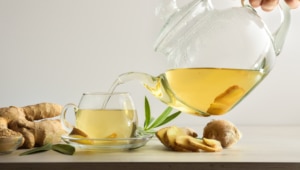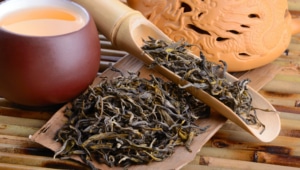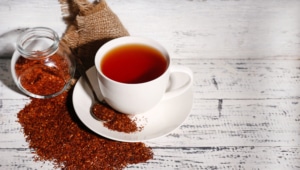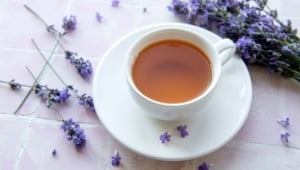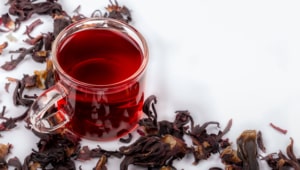7 Health Benefits of Peppermint Tea & 3 Tips
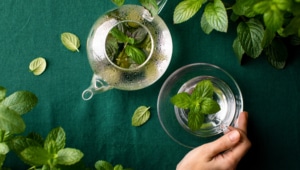
Peppermint tea appears to date back to the ancient Egyptians. Dried peppermint leaves were found in pyramids from around 1000 BC. In this article we’ll explore some of the top ways you can use peppermint tea to improve your health. Plus whether fresh or dried tea is better.
Interestingly, peppermint is actually a hybrid plant — a mix of spearmint and watermint. Nowadays, it’s a popular beverage almost everywhere in the world. But peppermint tea doesn’t just taste delicious and refreshing, it offers plenty of health benefits as well.
This vibrant tea has long been used to treat a variety of ailments. It’s well-known for treating digestive problems, helping relieve headaches, freshening your breath, and helping with stuffy noses during cold season. There’s much more to peppermint tea though.
What Peppermint Tea Is: Interesting Facts

What Peppermint Tea Is: Interesting Facts
The peppermint plant is actually a hybrid of watermint and spearmint. It has square stems and fragrant green leaves. If you let it flower, it will develop purplish-pink flowers, which are great for use as garnish on salads.
Peppermint tea can be stored for a long, long time, so long as you keep it in an airtight container. This way it will keep its beautiful smell and flavors.
You can easily dry your own mint leaves at home, from the garden, to use as tea. Mint is a particularly easy plant to grow in the garden, and will thrive in most places.
Fun fact: The mint family was named after a Greek nymph called Minthe, said to have been the lower of the god Pluto. Pluto’s wife found out about the affair and, in a fit of rage, murdered Minthe. To remember her, Pluto brought Minthe back in the form of a fragrant, well-loved plant.
An interesting fact about fresh vs dried peppermint tea: while both are delicious, some nutrients are lost when herbs are dried. Taste-wise, fresh peppermint will have a clean, bright taste, while dried peppermint can become a little more bitter.
With that said, dried peppermint is more readily available for most people when they just want a quick cup of tea.
Origin and Where Peppermint Tea Comes From

Origin and Where Peppermint Tea Comes From
The history of peppermint tea goes back to about 1000 BC. Dried peppermint was found in pyramids from this time, documenting its usage. Even then, peppermint tea was used to treat digestive issues.
Originally, peppermint tea was grown in Europe and Asia. Peppermint tea is grown in the North and East of the USA and the South of Canada.
However peppermint grows almost anywhere in the world and can easily be cultivated in your own garden or on a balcony.
What Peppermint Tea Is Made Of

What Peppermint Tea Is Made Of
Peppermint tea is made from leaves of the peppermint plant, which is a hybrid of watermint and spearmint. Peppermint is known as ‘mentha x piperita’, and can readily be grown by garden novices.
All parts of the plant are edible, and you can use any of them to make your own tea at home.
If you are using homegrown mint, be aware of the fact that there is one type of highly poisonous mint known as pennyroyal (metha pulegium).
The way to distinguish them is that pennyroyal tends to be a more ground-covering plant with smaller, rounder-shaped leaves that don’t have any ‘teeth.’
If you have a mint plant in your garden which you haven’t planted yourself, be very sure that it’s peppermint or one of its other edible cousins before using it. Pennyroyal can cause severe liver injury and even death when consumed.
What Peppermint Tea Tastes Like

What Peppermint Tea Tastes Like
Peppermint tea tastes a lot like gum, mints, or even peppermint candy canes. It doesn’t have much of a natural sweetness, but offers a refreshing menthol flavor.
Does Peppermint Tea Have Caffeine?
Peppermint tea contains no caffeine, making it an ideal choice for any time of day. It’ll give you a nice zingy boost in the morning, and relax you at night before bed.
Nutritional Facts and Calories of Peppermint Tea

Nutritional Facts and Calories of Peppermint Tea
Peppermint contains vitamin A, vitamin C, menthol, iron, and potassium. It also contains antioxidants such as flavonoids and polyphenols, which help rid your body of free radicals that could cause damage to your cells.
Peppermint tea contains no calories on its own, however it will have some calories if you add dairy or sweeteners.
Peppermint tea with skimmed milk, or a peppermint tea latte, can be delicious, and will only set you back around 10 calories of your daily intake.
Health Benefits of Drinking Peppermint Tea

Health Benefits of Drinking Peppermint Tea
Peppermint tea is full of healthy benefits for both your body and mind. It’s readily tolerated by most people, and can easily be grown in a pot or garden.
Here we go into some of the top ways adding peppermint tea to your diet can help improve your health.
May Help with Digestive Problems
Peppermint tea is well-known to help with all kinds of digestive issues. It’s great for releasing excess gas, relieving an upset stomach, and even relaxing your stomach to help you digest your food more efficiently. It’s also good for treating feelings of nausea, making it a helpful option for pregnant women.
Relieves Tension Headaches and May Help with Migraines

Relieves Tension Headaches and May Help with Migraines
It’s been shown that peppermint tea can help with tension headaches — the most common type of headache you might get.
Peppermint tea can help soothe and relax you, easing headaches and helping with migraines. The taste and smell of peppermint can also help with associated nausea, which is great.
Helps You Breathe Easier when Your Sinuses are Clogged

Helps You Breathe Easier when Your Sinuses are Clogged
If your sinuses are clogged because of a cold, an infection, or bad allergies, you might find peppermint tea a helpful remedy. Peppermint contains menthol oil, which can help with sinus pressure when inhaled.
It’s also full of anti-inflammatory and antibacterial properties, to help you fight off infections and soothe inflamed sinuses.
Might Improve Sleep and Ease Anxiety

Might Improve Sleep and Ease Anxiety
Peppermint tea can help calm down feelings of anxiety and improve your sleep. The latter is actually due to its relaxing properties and ability to soothe your digestive system.
Having peppermint tea after your dinner, around an hour before bedtime, can help you drift off to a more relaxed sleep.
Could Boost Your Energy Levels

Could Boost Your Energy Levels
This delicious, refreshing tea can help give you a boost of energy when you feel lethargic. Peppermint doesn’t contain caffeine or other stimulants, but will give you a little zing.
It may improve your focus levels, alertness, and overall energy.
The refreshing, slightly cooling flavors of peppermint tea could also add to this effect.
Freshens Bad Breath and Helps with a Sore Mouth

Freshens Bad Breath and Helps with a Sore Mouth
Menthol in peppermint tea is renowned for making your breath smell better. This makes peppermint tea an excellent choice as a post-meal drink, and doubly so as it promotes better digestion.
You may even wish to gargle with peppermint tea at night, to help improve bad breath naturally. The antibacterial and anti-inflammatory properties of peppermint also help if you have a sore mouth or toothache.
May Help Ease Period Pain and Cramps

May Help Ease Period Pain and Cramps
Peppermint tea can relax your stomach and ease period cramps. It can also help with sore bowel movement associated with period pains, and with nausea.
If you’re feeling particularly irritable, you may also find that peppermint tea helps relax your mind and ease mental symptoms of PMS.
Potential Risks

Potential Risks
As with any type of tea or herbal remedy, peppermint tea also comes with some small risks. As far as teas are concerned it’s one of the most low-risk types you could consume. Most people should have absolutely no problem drinking up to 3 to 5 cups of peppermint tea per day.
Could Make Heartburn or Reflux Worse
Peppermint tea can relax the muscle separating your esophagus from your stomach. This can make symptoms of indigestion and heartburn worse by allowing acids in your stomach to travel back upwards.
If you regularly suffer from reflux or heartburn, you may wish to steer clear of peppermint tea.
May Cause Allergic Reactions

May Cause Allergic Reactions
Some people can be allergic to mint plants. If you’re allergic, peppermint tea can cause unwanted symptoms such as hives, itching, a cough, and wheezing. In severe cases it may cause serious harm.
If you’re allergic to other types of mint, you’ll probably be allergic to peppermint, too. With that said, mint allergies are very rare.
Is Peppermint Tea in Pregnancy Good For You?

Is Peppermint Tea in Pregnancy Good For You?
Peppermint tea is widely used in pregnancy, and isn’t harmful for you or your baby so long as you don’t drink it in excess. One to two cups of herbal tea such as peppermint tea per day is generally considered safe.
The reasons why pregnant women like peppermint tea are plenty: it can soothe nausea and upset stomachs, make you feel more relaxed, and it’s completely caffeine free.
It can also help with headaches, which is good news given how little medication you can actually take while pregnant.
If you’re very cautious, you may wish to skip on peppermint tea until your second trimester. With that said, there are no documented stories of miscarriages caused by peppermint tea, and it really does seem to be one of the safest options.
If in doubt, just speak to your doctor before adding peppermint tea to your pregnancy diet.
If you’re using peppermint from your garden to make tea, make sure you’re 100% certain that it is indeed peppermint and not another type of mint or toxic pennyroyal.
Spearmint and watermint are both possibly unsafe when taken during pregnancy, so avoid these.
Simple Guide for Making the Perfect Peppermint Tea

Simple Guide for Making the Perfect Peppermint Tea
If you’re making peppermint tea and have access to fresh peppermint tea from your balcony or garden, you’re in for a treat.
Fresh peppermint has more nutrients than its dried tea counterpart, so you’ll reap even more of the beneficial effects for your health.
This recipe is very easy to follow, and you can modify it to taste by adding different sweeteners or mixing it with green tea for an extra boost of energy.
Ingredients:
- 1 ½ cups of water
- 2 sprigs of fresh peppermint
- 1 tsp of honey
- 1 slice of fresh lemon or lime
And here’s how you do it:
- Boil the water and pour it into two cups. Glass cups or heatproof serving glasses are particularly nice for this.
- Add a sprig of fresh peppermint each, as well as the honey and lemon or lime slices.
- Steep for 3-5 minutes and serve. You can present these with the sprigs of mint still in the glasses, as they look so pretty. Offer a small plate to take the mint out when it comes to drinking your tea.
Tips for Drinking and Serving Peppermint Tea

Tips for Drinking and Serving Peppermint Tea
Peppermint tea is one of the easiest hot beverages to enjoy at home. If you just make it from a good quality dried tea, it’ll be just fine. However, if you’re looking to up the ante a little bit, below are some tips for really taking your peppermint tea to the next level.
Use Fresh Peppermint from Your Garden

Use Fresh Peppermint from Your Garden
Fresh peppermint tea tastes brighter and more clean than its dried counterpart. It offers more nutrients and, therefore, more health benefits.
Fresh peppermint is also less likely to turn bitter when steeped in hot water. With that said, you’ll want to be sure you’re using peppermint and not its toxic relative, pennyroyal.
Make a Peppermint Candy Cane Latte

Make a Peppermint Candy Cane Latte
Follow your favorite tea ‘latte’ recipe by mixing peppermint tea with a milk of your choice. Foamed milk is particularly lovely.
Add a peppermint candy cane as a stirrer, which will also give added sweetness to your latte. This is a particularly lovely festive treat around Christmas-time, and super easy to make.
Find here all of the health benefits of black tea.
Enjoy a Traditional Moroccan Mint Tea

Enjoy a Traditional Moroccan Mint Tea
Mint tea is a popular tradition in Morocco. Enjoy a cup of Moroccan peppermint tea at home by steeping fresh peppermint in hot water (per our recipe above), but mixing it with some green tea.
Stir in liberal amounts of sugar until blended, and enjoy. Moroccan mint tea is renowned for being very sweet and delicious.
- Chai Tea. Health Benefits and Hacks.
- Raspberry Leaf Tea. Tips, Hacks and Health Benefits.
- Starbucks Refresher. Tips and Best Drinks.
- Jelly Belly Flavors. Best and Grossest.
- Boba Flavors. Best Flavors and Types.
- Pop Tart Flavors. Tasty Alternatives and Best Flavors.
- Cinnamon Tea. Health Benefits and Tips.
- Almond Milk. Benefits & Tips for Using.
